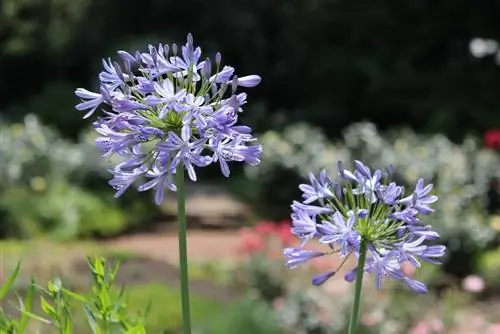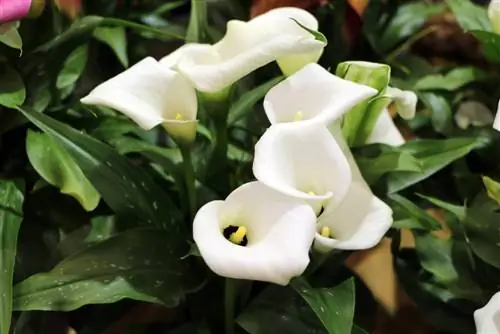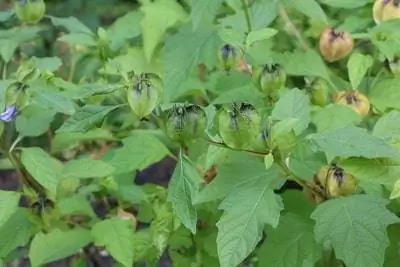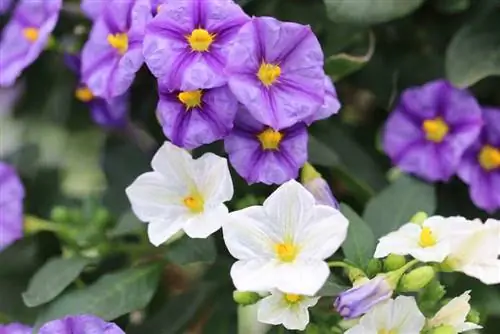- Author admin [email protected].
- Public 2023-12-17 03:39.
- Last modified 2025-01-24 12:45.
The heart-shaped 6 to 12 cm long leaves of the Judas tree appear before the leaves have sprouted. They are colored blue-green on the upper side and have a gray-green underside. In autumn the leaves turn ocher to orange-yellow. In April the plant is adorned with pink, delicately scented flowers that come together in clusters. Some of these grow directly from the trunk on perennial wood (stem flowering), which is considered a botanical peculiarity. The inflorescences are arranged in a raceme shape and consist of only 3 to 6 flowers.
The fruits of the Judas tree form from the flower and appear in the form of brown, elongated pods that often remain hanging until spring. They are approximately 5 to 6 cm in size. The tree's smooth bark is gray to gray-green in color and turns dark brown with age. The branches are shiny and colored a dark brown.
Species
The Judas tree can be found in different species, which are characterized by different flower colors. For example, in addition to the pink flowers, there are also pure white flowers. The best known species include:
- Chinese Judas tree, which is quite resistant to frost
- Canadian Judas tree, which is very robust and has reddish foliage
- Alba, whose flowers are white
- Common Judas tree, which is very sensitive to frost when young
Size and growth
The plant used as an ornamental tree reaches a height of 4 to 8 meters, in rare cases even more. In width, the tree reaches dimensions of around 4 to 6 meters. As it ages, it forms a sprawling, loosely structured crown. The plant grows approx. 30 to 50 cm per year and is therefore one of the normal-growing trees.
Usage
In addition to the stem flowers, the flowers have another special feature. They have a sweet and sour taste and are edible. They are often used especially in salads. The fruits are also edible, but have an unusual taste. The wood of the Judas tree is considered to be particularly hard and has a great grain. Therefore it is used as veneer wood.
Location

This multi-stemmed small tree loves very sunny and warm conditions and should be planted somewhat sheltered from the wind. The Judas tree prefers to sit in a rather dry, water-permeable and calcareous clay soil. The tree is very resistant to drought. It is hardy down to minus 16 °C, although young trees should be protected in the first few winters if they grow in cold areas. The plant can be used in a variety of ways and is ideal for fencing or facade greening. Since it is very easy to care for, it is often used as park planting, in pedestrian zones or in front gardens. In some locations, however, the tree forms root extensions with which it can cause damage to floor coverings even many meters away. The Judas tree can be grown on a trellis just like climbing plants and is suitable as a solitary plant or as a plant in groups.
Cutting and propagating
Pruning is rarely necessary and should only be done on bare, damaged or diseased branches. The picturesque growth of the Judas tree is negatively affected by cutting. The tree is propagated via cuttings or seeds and is very difficult. This is therefore reserved for specialists.
Further care instructions:
- Planting time: spring at best
- Preparation of the soil: for heavy soils, mix in some potting soil
- Fertilizing: not necessary if the location is right, in the bucket every 14 days
- Watering: water moderately, the soil should never dry out completely
- Overwintering: Potted plants should be kept in frost-free and bright rooms
Diseases and pests
The Judas tree is very resistant to diseases. However, it is one of the most affected trees when it comes to verticillium wilt. The disease becomes noticeable when the tree has wilted leaves despite sufficient water supply. First some shoots die, then branches and after a while the entire tree. If the bark is scraped near the ground, brown colored water pipe lines become visible. This is a sure sign of Verticillium wilt. The pathogens are harmful fungi that can clog the tree's water pipes. If this disease is infested, the branches should be cut back to he althy wood. However, the Judas tree does not have particularly great chances after an infestation. Control agents don't help here.
If the plant has fallen victim to the disease, it may make sense to dispose of the tree, including the roots and all of the soil, in the trash. The pathogens can easily survive in the soil for many years and spread to other plants. To prevent this, the cultivation conditions should be maintained optimally and the roots should not be damaged.
In addition to this disease, similar symptoms with a less dangerous cause can also occur. This is often a more harmless fungal disease or incorrect culture conditions. With these problems, however, the water pipes are not blocked, which makes the distinction easy. To combat this, the fallen leaves should be removed from the ground. Dead branches must also be completely removed immediately. Infected shoots should be cut back to a depth of approx. 50 cm into he althy wood. In this case, it is also important to fertilize the Judas tree. Cutting should be done in dry and, if possible, sunny weather, so that the interfaces close quickly.
What you should know in brief
The magnificent Judas tree is pleasantly noticeable in early spring with its splendor of flowers. It is very undemanding and, due to its relatively small size, is also suitable for small gardens. Since it hardly needs to be cut, it requires little care and is suitable for gardening beginners as well as professionals.

The name of the tree has its origins in biblical history and here with Judas, the betrayer of Jesus. He is said to have hanged himself on such a tree. In addition, the round leaves are intended to commemorate the pieces of silver that Judas received for his betrayal. People who are solid in the Bible will know what we are talking about. Everyone else can find out more if they are interested.
- The Judas tree genus includes six species that occur in Europe, Asia and North America, especially in New Mexico.
- The Judas tree reaches a height of up to ten meters and also prefers an altitude below four hundred meters.
- As far as the soil is concerned, the Judas tree is not very spoiled. It is happy with calcareous or stony soils.
- It grows in sparse forests and wherever else you want it.
- The Judas tree has leaves that are bright green, and in the sun they even shine a little silver. They are arranged alternately and have a kidney-shaped basic shape. The leaves can be up to twelve centimeters long.
- The fruits of the Judas tree are reminiscent of long pea pods, they are long pods that are initially delicate green and then later turn brown.
In order to move on to the flowers of the tree, a definition is first necessary, namely that of kaulifloria. Cauliflory refers to the stem flowers of a plant. This characteristic occurs particularly in tropical plants; it means that flowers emerge from older parts of the stem. It is particularly beautiful to look at when the trunk is in bloom. There are very few trees for this purpose in Europe, but one of the few is the Judas tree, which can be found in many gardens here as an ornamental tree.
- The flowers appear before the foliage, are pink to purple and appear in clusters on twigs, on thick branches and also, as mentioned, on the trunk.
- They are arranged in short bunches like butterfly flowers and delight the gardener's heart, especially when they bloom where no one expects them, namely on the trunk.






